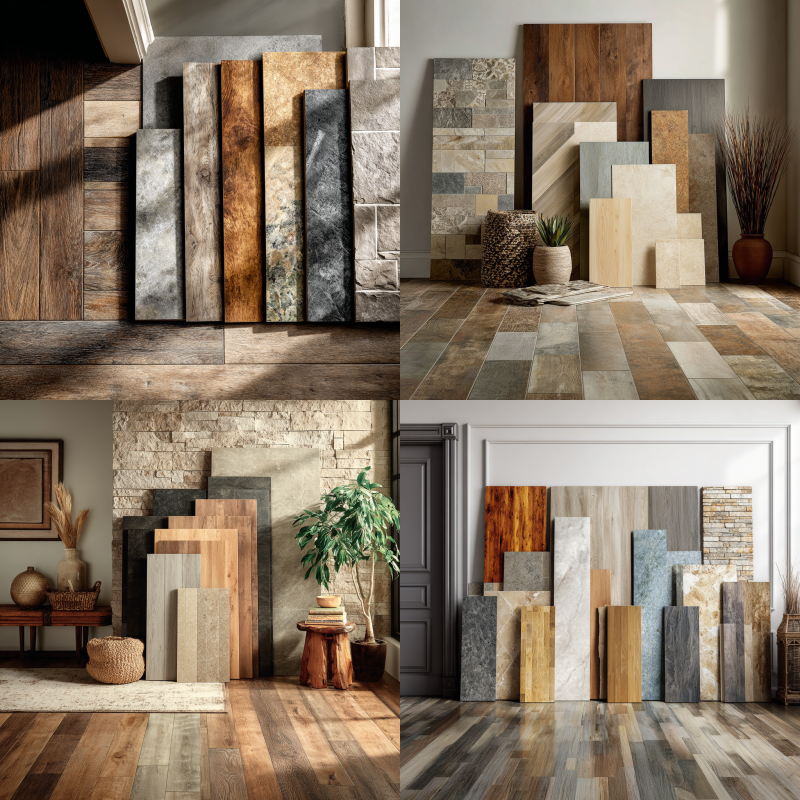
What Are the Different Types of Flooring Materials?
Explore the basics: what are the different types of flooring materials
What Are the Different Types of Flooring Materials? There is no one-size-fits-all solution. Different materials handle different conditions, whether it’s an active household with kids, a busy commercial lobby, or a cozy apartment. If you want a broad overview of installation supplies and techniques, you can look into types of flooring installation materials. For now, let’s walk through each major category so you know exactly what you are dealing with.
Tile flooring
Tile flooring usually comes as ceramic or porcelain squares, though you will also find unique shapes like hexagons. Its strength lies in water and stain resistance, making it ideal for kitchens or bathrooms, where spills happen daily. According to Complete Flooring Interiors, tile floors do not require complicated maintenance—an occasional mopping usually suffices.
Pros
- Extremely durable, resists stains and moisture.
- Wide range of colors and patterns.
- Easy to clean, which is great if you have a busy lifestyle.
Cons
- Can feel cold and hard underfoot, especially in winter.
- Does not muffle sound well, so footsteps may echo on upper floors.
- Grout lines can require extra scrubbing if neglected.
This density asks for a solid subfloor. If you are uncertain how to prep the surface, what is the best way to prepare a subfloor for installation can help you align your subfloor condition with tile requirements. Good news: once installed correctly, tile can last for decades.
Hardwood flooring
Hardwood floors are made of solid planks from oak, maple, walnut, or other woods. In well-kept conditions, many hardwood floors can last you 30 to 100 years, as reported by DuraMagicFloor. You get a warm, timeless look that boosts a home’s value. Plus, hardwood is relatively straightforward to refinish, so you can restore it if it accumulates scratches.
Pros
- Natural beauty and warmth.
- Can be refinished multiple times.
- High resale value, especially for classic wood types.
Cons
- Higher upfront cost than laminate or vinyl.
- Susceptible to water damage if spills are not cleaned quickly.
- May require extra upkeep, especially in humid climates.
A close cousin to solid hardwood is engineered hardwood. It combines a real wood top layer with a stable plywood base, making it less prone to warping. If you want more details on this option, check out what is engineered hardwood flooring.
Laminate flooring
Laminate floors imitate the look of wood, tile, or stone by layering a high-resolution image over composite materials. Studies show laminate can be used in almost any room—living spaces, bedrooms, or even basements—and usually comes at a fraction of the cost of hardwood [2]. Abrasion ratings, found on laminate packaging, guide you toward the right durability level. For active homes or moderately busy offices, you might pick AC4 or AC5-rated options.
Pros
- Budget-friendly while giving the illusion of natural materials.
- Scratch-resistant surface, helpful for households with pets.
- Usually easy to install, thanks to click-and-lock planks.
Cons
- Some laminates may swell if water seeps into seams.
- Cannot be refinished once worn out.
- May not feel as “solid” underfoot as real hardwood.
If you are curious about installation tips or the difference between laminate layers, you might check out what is laminate flooring. Installing laminate often goes faster than you think. Compared to tile or hardwood, you typically skip mortar and grouting.
Vinyl flooring
Vinyl flooring, often made from PVC and fiberglass, appeals for its durability and water resistance. It is popular in places like bathrooms, entryways, or kitchens, where you expect a fair amount of foot traffic. Luxury vinyl tile (LVT) can mimic hardwood or stone, and it is widely used in hospitals, schools, and restaurants because it manages spills well. As Spectra Contract Flooring notes, LVT can stand up to daily abrasions and moisture.
Pros
- Waterproof construction, great for bathrooms or kitchens.
- Comfortable underfoot, with some options offering extra cushioning.
- Low maintenance, requiring only routine sweeping and occasional mopping.
Cons
- Limited ability to fix deep scratches.
- Lower status appeal compared to real wood or stone.
- Potential off-gassing when poorly constructed.
Many vinyl products are peel-and-stick or glue-down, making them more DIY-friendly. If you have concerns about removing old flooring or leveling the subfloor, look into flooring pre-installation preparation for the best results.
Stone flooring
Stone flooring includes granite, marble, slate, limestone, and sandstone. Each slab is cut directly from natural stone, offering a unique pattern that enriches any room’s aesthetic. Many commercial sites choose stone for its high durability and water resistance (especially granite or slate). This can be crucial in high-traffic areas like hotel lobbies or large entryways, as indicated by DuraMagicFloor.
Pros
- Striking visual impact, adds a luxurious feel.
- Durable if sealed and maintained properly.
- Naturally water-resistant, though exact level varies by stone type.
Cons
- High cost for materials and installation.
- Feels cold and can be slippery if polished too smooth.
- Periodic resealing is required to prevent stains.
Slate and terrazzo often serve commercial spaces that endure heavy daily traffic. Terrazzo, for instance, resists serious wear but involves higher initial investment, recommended mostly for areas above 2,500 square feet [3].
Other flooring options to consider
Beyond the common categories, you will also find a range of eco-friendly or commercial-grade materials:
- Cork: Harvested from tree bark, offering a soft, warm surface. It is hypoallergenic, resists moisture, and insulates against noise. Proper sealing is still needed, but cork can be maintained like hardwood [4].
- Bamboo: Technically a fast-growing grass, this is a durable, formaldehyde-free choice that is both sleek and environmentally stable. Like hardwood, it can be sanded and refinished, though not as many times.
- Marmoleum: A natural linoleum made from linseed oil, wood flour, and cork dust. It is durable, non-toxic, and easy to clean, making it a greener alternative to standard vinyl [4].
- Polymer floors (Rubber, Epoxy, etc.): Common in high-traffic commercial areas such as gyms or cafeterias. Rubber flooring is noise-reducing and slip-resistant, while epoxy coatings triple the lifespan of concrete floors, as McLean Company points out.
- Carpet tiles: A flexible, budget-friendly option for commercial spaces. They are simpler to replace than traditional broadloom, making them practical if you expect spills or wear in certain zones.
If some of these materials intrigue you, keep in mind that each has unique prep work. For example, rubber flooring might require a perfectly level surface, while epoxy calls for meticulous cleaning before application to ensure a strong bond. You can learn more from specialized guides like how to prepare your home for flooring installation.
What are the different types of flooring materials that fit you best
By now, you have seen a range of choices—tile, hardwood, laminate, vinyl, stone, cork, and more. Each one offers something unique, from the cool elegance of stone to the cozy comfort of cork. This flooring material comparison reveals that room selection matters significantly. If you are deciding for your living room, you might lean toward hardwood or laminate for a warm ambiance. For kitchens and bathrooms, tile or vinyl often top the list because they handle spills so easily. Commercial spaces that see heavy foot traffic could benefit from epoxy or rubber floors that minimize slip risks and withstand years of wear.
No matter which path you take, it is wise to plan ahead. A successful flooring project starts with leveling the subfloor, gathering proper materials, and checking for moisture issues. If you wonder about the right next step, see flooring pre-installation preparation for a handy checklist. Taking that extra time sets you up for a long-lasting and beautiful result. You have got this—you are equipped with the knowledge to choose wisely and enjoy your new floors for years to come.
Ready to Transform Your Home?
At Mazzamuto Construction, we believe great spaces start with thoughtful planning and skilled craftsmanship. Whether you’re exploring ideas or ready to build, our team is here to guide you every step of the way. Let’s bring your vision home—reach out for a personalized consultation today!
Frequently asked questions
1. What are the different types of flooring materials?
There are several popular types of flooring installation materials, including hardwood, laminate, vinyl, tile, and carpet. Each offers unique benefits—hardwood adds natural beauty, laminate is cost-effective and DIY-friendly, while vinyl and tile are durable and water-resistant. Learn more about your options on our Flooring Sales and Installation page.
2. What is engineered hardwood flooring?
Engineered hardwood flooring is made of a real hardwood veneer layered over a plywood or fiberboard core. It provides the beauty of solid wood while offering better resistance to moisture and temperature changes. This makes it a great choice for basements and humid areas.
3. What is laminate flooring?
Laminate flooring is a multi-layer synthetic product designed to mimic the appearance of wood, stone, or tile. It features a photographic surface layer, a durable wear layer, and a core made from high-density fiberboard. Laminate is popular for its affordability, ease of installation, and low maintenance.
4. Is engineered hardwood better than solid hardwood?
It depends on your environment. Engineered hardwood resists variations in humidity, making it more stable in basements or bathrooms. If you prefer an all-wood feel and plan to refinish often, solid hardwood might be your best bet.
5. Can I install new flooring by myself?
Many people handle laminate or vinyl as a DIY project, but tile, stone, or hardwood may require professional skills to ensure proper alignment and longevity. Mistakes in subfloor prep or sealing can be expensive to fix.
6. Which floors offer the best resale value?
Traditional hardwood floors often carry high resale value, especially when they have been well maintained. However, engineered hardwood is also a strong contender since it offers a similar aesthetic with more moisture resistance.
7. How do I maintain a newly installed floor?
Follow the manufacturer’s recommendations, from seasonal cleaning to refinishing schedules. For wood, you may want to read how to maintain new hardwood floors after installation.
Key takeaway
- Focus on the room’s needs. Kitchens with heavy spills might do best with tile or vinyl.
- Consider your climate. Engineered hardwood and rubber floors handle humidity well.
- Balance aesthetics and practicality. Real wood looks classic, but laminate can be more budget-friendly.
- Factor in long-term maintenance. Floors like tile and vinyl are easy to clean, while hardwood adds refinishing steps later.
- Prep is essential. A well-prepared subfloor and the right supplies are vital for a floor that lasts decades.




